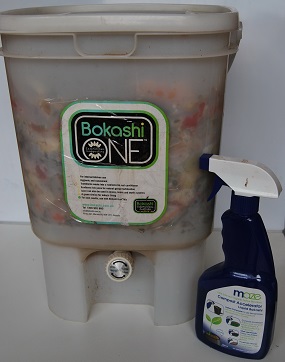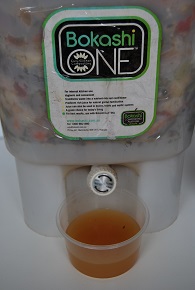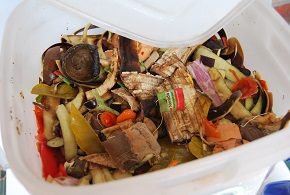Follow these steps to make the most of your Bokashi system.
BOKASHI BUCKET INSTRUCTIONS
1. Every day, collect all food scraps – vegetable and fruit scraps as well as any leftovers from your meals. No bones or paper products.
2. Put all of these scraps into the Bokashi bucket. Make each layer no deeper than 5cm.
3. Push them down with the mashing tool. This is to exclude any air.
4. Sprinkle a small handful (half a cup) of the Bokashi grain over the scraps. If you are adding high protein scraps, such as meat, fish, cheese and eggs, add more of the Bokashi grain. Alternatively, use the Bokashi spray activator over your scraps.
5. Shut the lid tightly and leave it.
Repeat this layering process until the bucket is full and top up with a generous layer of the Bokashi grain. or squirt of the activator.
Bokashi Juice
Every few days, open the tap and drain out any of the Bokashi juice which collects in the bottom part. You can use this on your trees and plants every 2-3 weeks. It MUST be diluted. Mix it with water with the dilution rate of 1 teaspoon to 2-3 litres of water. For trees and shrubs, use 2 teaspoons to 2-3 litres of water.
If you get too much juice and you can’t use it, store it in a bottle with a lid in the fridge. It will keep for several days but is best used fresh. Make sure you label it so you don’t go to drink it by mistake! It can also be used in kitchen and bathroom drains, toilets and in septic systems. This way it helps our waterways by contributing ‘good’ bacteria.
Emptying Your Bokashi Bucket
When the bucket is full of scraps, leave it sit for about 10-14 days. While this is fermenting, begin the process again in a second bucket. After this time, you can add it to your garden somewhere by burying it under the soil; or adding it to your compost bin.
Sometimes you might see a white cotton-like fungi growth on the surface of your Bokashi bucket contents. Don’t panic! – it’s a sign that the fermentation process has occurred.
When you clean the Bokashi bucket in between emptying it and starting to fill it again, wash it out but don’t use any soap or detergent.
*To purchase a Bokashi bucket with council subsidies, log onto www.CompostRevolution.com.au Not all councils are taking part in this initiative but check it out.
*If you have nowhere to empty your bucket, or would like more food scraps to fill a bucket, become part of the SHAREWASTE.com network.


